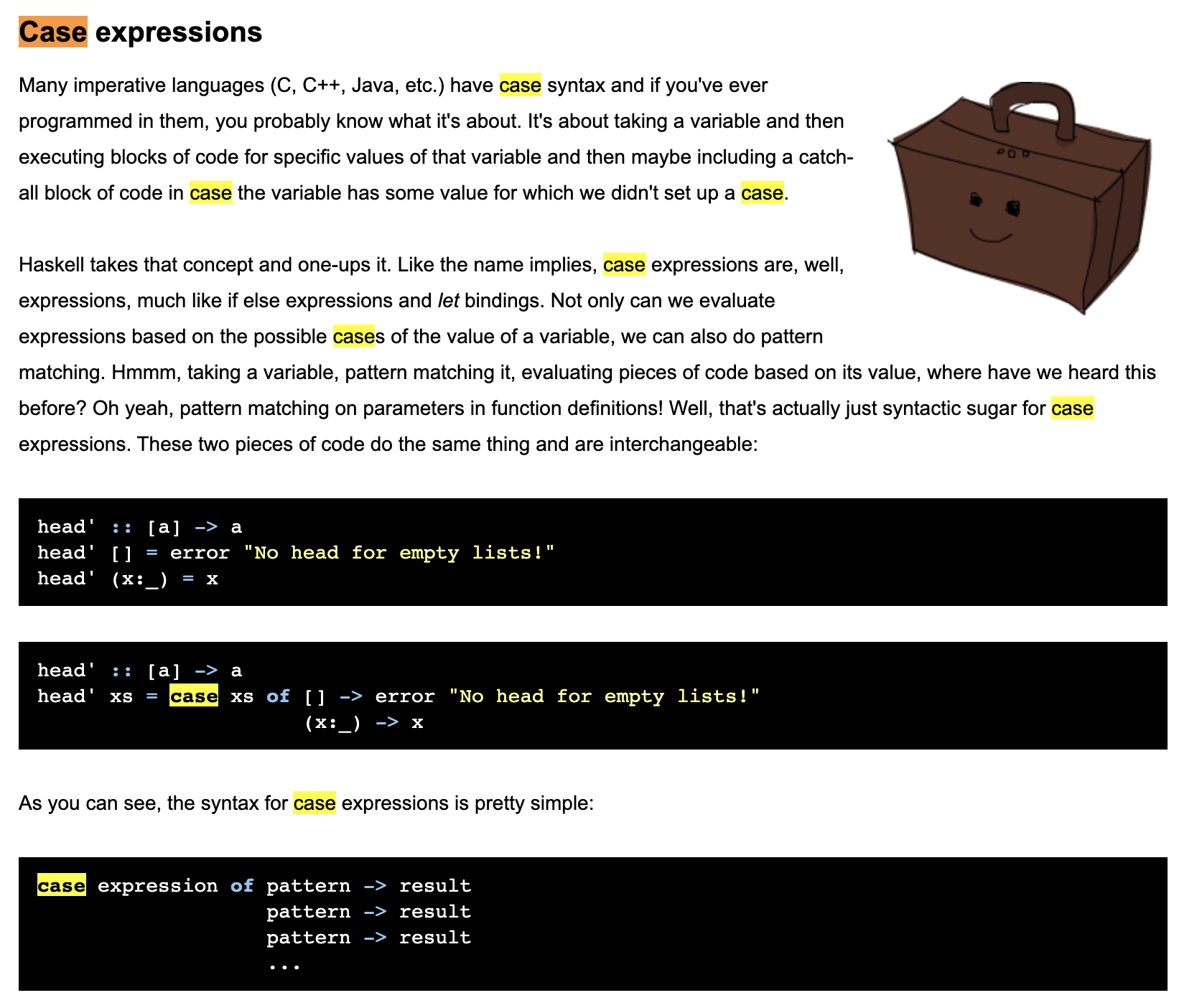对Discrete Mathematics Using a Computer的第一章Introduction to Haskell进行总结。环境Windows
函数毫无疑问是函数式语言的核心。
在Haskell中(无特殊指明,以下皆是指在Haskell下),一个表达式用函数完成计算被称为a function application,函数后加空格然后跟随参数(arguments),如有多个参数,也以空格作为分隔。
函数的返回值即函数的类型,如一个函数的参数是类型a,返回值是类型b,写作a → b(在Haskell中用 -> 表示),读作a arrow b。
操作符其实也是函数,它有2个参数,写在2个参数中间,其实也可以像正常函数一样写在前面,但需要加( )如:

同样的,也可以像对待操作符一样将函数放在2个参数中间,但要加反引号( single-back-quote, ` ),如:

将函数定义在Haskell脚本文件(.hs)中,载入(在ghci中 :load)后,即可使用。
函数的声明:
function_name :: argType1 -> argType2 -> ... ->argTypen ->resultType
函数体:
function_name arg1 arg2 ... argn = expression that can use the arguments
模式匹配pattern matching
在定义函数时,为应对不同情况,可以有多个函数体,如:f :: Integer -> String
f 1 = "one" f 2 = "two" f 3 = "three"
在得到参数执行时,会从第一条开始比较是否符合,当遇到符合的才会执行,执行后即该函数执行完成,如果没有符合的会报错,如:

元组和list都可以作为函数参数,其中list有两种形式:
1. [1,2,3, x ] -- 表示list中有具体个数
2. x:xs -- 表示至少有1个元素的list
3. xs -- 通用的list,包括空list
当用x:xs的时候,可以使用@来给整个列表命名,如lst@(x:xs),则在之后的代码中可用lst来指代(x:xs)。
练习题:

我的答案:
exercise3 :: Char -> Bool exercise3 'a' = True exercise3 x = False exercise4 :: String -> Bool exercise4 "hello" = True exercise4 x = False exercise5 :: String -> String exercise5 (' ':xs) = xs exercise5 xs = xs
另一种应对多种值的方法:guards。即使用bool表达式判断是否符合条件,符合则执行该行。
fact :: Integer -> Integer fact n | n < 0 = 0 | n == 0 = 1 | otherwise = n * fact (n - 1)
高阶函数higher order functions
参数和返回值都是正常的数据类型则该函数是一阶函数(first order)。以别的函数作为参数或者以其他函数作为返回结果则是高阶函数(higher order)。如:
twice :: (a -> a) -> a -> a
twice f x = f (f x)
函数是一次接收一个函数进行处理的,比如一个需要2个参数的函数 ,如果只给出第一个参数,那么返回的是一个需要一个参数来完成原函数的新函数(partial application)。
prod :: Integer -> Integer ->Integer prod x y = x * y g = prod 4 p = g 6 q = twice g 3

条件表达式conditional expressions
样式:
if Boolean_expression then exp1 else exp2 --then和else都必须要有,exp1和exp2的type一样。
局部变量local variables: let Expressions
当某个固定式子被多次使用时,为了方便可以定义为局部变量。
样式:
let equation
equation
...
equation
in expression
上式的值为in后的expression。以求一元二次方程程序为例,要注意Tab缩进:
quadratic :: Double -> Double -> Double -> (Double, Double) quadratic a b c = let d = sqrt (b^2 - 4 * a * c) x1 = (-b + d) / (2 * a) x2 = (-b -d) / (2 * a) in (x1, x2)
要注意从let到in expression,其整体就是一个表达式,如下所示:

let x = sqrt 9 in (x + 1) * (x - 1)的值为8.0(x的值为3.0),所以2 + let x = sqrt 9 in (x + 1) * (x - 1)的值为10.0。
case

局部变量local variables: where
另一种表达局部变量作为helper是where。如:
maximum :: [Int] -> Int
maximum [x] = x
maximum (x:xs)
| x > maxxs = x
| otherwise = maxxs
where maxxs = maximum xs
类型变量type variables
类似与Java中的泛型generics,在定义函数时不明确其类型,在应用时,根据传入参数的类型确定,这样就只要定义一个函数就可以应对多种不同类型,而不用为了类型不同,一一重复定义函数,体现了其多态性,在之前的例子中也有没有指明其类型而是用字母代替的,比如
fst :: (a, b) -> a
snd :: (a, b) -> b
类型变量必须以小写字母开头,通常用a,b...